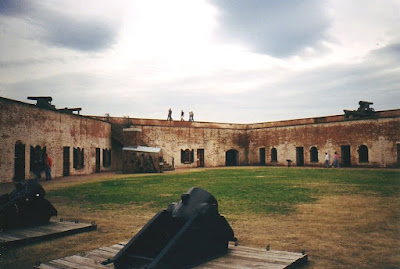Ft. Macon State Park
Located along
the southern shores of North Carolina's Outer Banks, Fort Macon State Park
is one of the many features of the Tar Heel State's Crystal Coast.
Fort Macon sits on the eastern tip of the Bouge Banks, a barrier island
that sits between Bouge Soung and Onslow Bay. Early in the 19th century,
Fort Macon was built to protect Beaufort Inlet and the towns of Beaufort
and Morehead City from pirate raids and powerful European Navies.
The fort saw relatively little action and inhabitancy from its completion
in 1834 to the start of the Civil War in 1861. (1) In fact, the fort
sat unoccupied, except for a single caretaker, for over 20 of the 27 years
between its being garrisoned in 1834 and 1861. (1)
The Fort was taken over by Confederate Soldiers in April 1861. However, it would only last in Confederate hands for one year, as Union forces under General Ambrose Burnside captured the Fort on April 26, 1862. (2) The Fort remained in Union control for the remainder of the war and served as a prison during the Reconstruction. (1) It would sit empty for 21 years until it was hastily re-garrisoned in 1898 for coastal protection during the Spanish-American War. In 1903, the fort sat empty once again until World War II. Fort Macon was then outfitted with modern arms and troops to defend the Beaufort Inlet against German submarines. (3) Although the fort saw no action, a number of American vessels and even a German sub was sunk nearby.
Today, Fort Macon State Park is one of North Carolina most popular parks, seeing over one million visitors a year. (4) The Fort was first handed over to the state in 1924 for a sum of one dollar. It would make Fort Macon, North Carolina's second state park. (2) It took another decade for the park to be restored for use. The fort's active duty in World War II technically lasted until 1946 when the military returned the property to the state.
Other features of the park include - sand dunes and nature trails around Beaufort Inlet. You can still find many remnants of the defenses used during the Second World War. The stone jetties that still protect the shore from beach erosion were first designed by Robert E. Lee in 1840. (5)
(1) Fort Macon Ramparts. "Fort Macon
History." http://www.clis.com/friends/History.htm
(June 15, 2003)
(2) NC Division of Parks and Recreation.
"Fort Macon State Park, Park History." http://www.ils.unc.edu/parkproject/visit/foma/history.html
(June 15, 2003)
(3) Branch, Paul. "World War II Comes
to Fort Macon." Fort Macon Ramparts. http://www.clis.com/friends/WorldWarII.htm
(June 15, 2003)
(4) Associated Press. "Fort Macon." WTVD-11
Raleigh. http://abclocal.go.com/wtvd/features/DonRoss/010303_DR_fortmacon.html
(June 15, 2003)
(5) Branch, Paul. "Robert E. Lee at Fort
Macon." Fort Macon Ramparts. http://www.clis.com/friends/LeeAtFM.htm
(June 15, 2003)
Fort Macon Civil War Roundtable
United States Coast Guard, Group Fort Macon
The Fort was taken over by Confederate Soldiers in April 1861. However, it would only last in Confederate hands for one year, as Union forces under General Ambrose Burnside captured the Fort on April 26, 1862. (2) The Fort remained in Union control for the remainder of the war and served as a prison during the Reconstruction. (1) It would sit empty for 21 years until it was hastily re-garrisoned in 1898 for coastal protection during the Spanish-American War. In 1903, the fort sat empty once again until World War II. Fort Macon was then outfitted with modern arms and troops to defend the Beaufort Inlet against German submarines. (3) Although the fort saw no action, a number of American vessels and even a German sub was sunk nearby.
Today, Fort Macon State Park is one of North Carolina most popular parks, seeing over one million visitors a year. (4) The Fort was first handed over to the state in 1924 for a sum of one dollar. It would make Fort Macon, North Carolina's second state park. (2) It took another decade for the park to be restored for use. The fort's active duty in World War II technically lasted until 1946 when the military returned the property to the state.
Other features of the park include - sand dunes and nature trails around Beaufort Inlet. You can still find many remnants of the defenses used during the Second World War. The stone jetties that still protect the shore from beach erosion were first designed by Robert E. Lee in 1840. (5)
 |
| Inside the grounds of Ft. Macon |
 |
| A cannon watches over Bouge Inlet |
 |
| Beaufort Inlet |




Comments